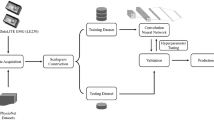Abstract
This paper proposes a gait intention detection (GID) method based on motion information from a single leg. This method detects three gait states: stair ascending (SA), stair descending (SD), and level walking (LW). The GID is a highly important factor for the control of gait assistive devices. If the GID is limited to the motion information from a single leg, analyzing the gait motions becomes more challenging, owing to the absence of information regarding the phase difference between both legs. To address this challenging, previous GID methods have used fusion data from several sensors. In this paper, only three inertial measurement units are used for proposed single leg GID method. To analyze gait motions using these limited sensors, the divergent component of motion (DCM) of the user is computed. The DCM is a physical quantity incorporating the linear position and linear velocity of the center of mass; these can be computed from the kinematic data of a support leg. In each of the three gait states SA, SD, and LW, the DCM shows different patterns. To classify and detect these different patterns, a pattern recognition method based on an artificial neural network algorithm is used. The GID performance of the proposed method was experimentally evaluated, and it showed 99% success rate for the SA, SD, and LW states.
Similar content being viewed by others
Code Availability
Not applicable.
References
Neuhaus, P.-D. et al.: Design and evaluation of Mina: a robotic orthosis for paraplegics, in Proc. IEEE Int. Conf. Rehab. Robot. 1–8 (2011)
Farris, R.-J., Quintero, H.-A., Goldfarb, M.: Preliminary evaluation of a powered lower limb orthosis to aid walking in paraplegic individuals. IEEE Trans. Neural. Syst. Rehabil. Eng. 19(6), 652–659 (2011)
Talaty, M., Esquenazi, A., Briceno, J. E.: Differentiating ability in users of the ReWalk ™ powered exoskeleton: an analysis of walking kinematics, in Proc. IEEE 13th Int. Conf. Rehabil. Robot. 1–5, (2013)
Fleischer, C., Hommel, G.: A human-exoskeleton interface utilizing electromyography. IEEE Trans. Robot. 24(4), 872–882 (2008)
Sankai, Y.: HAL: Hybrid assistive limb based on cybernetics. Robot. Res. 66, 25–34 (2010)
Zhang, F., et al.: Real-time implementation of an intent recognition system for artificial legs. Proc. Conf. IEEE Eng. Med. Biol. Soc. 2011, 2997–3000 (2011)
Tkach, D., Huang, H., Kuiken, T.: Study of stability of time-domain features for electromyographic pattern recognition. J. Neuroeng. Rehabil. 7(21), 1–13 (2010)
Pappas, I.P., et al.: A reliable gait phase detection system. IEEE Trans. Neural. Syst. Rehabil. Eng. 9(2), 113–125 (2001)
Formento, P.C., et al.: Gait event detection during stair walking using a rate gyroscope. Sensors 14(3), 5470–5485 (2014)
Zarika, M. et al.: Heuristic based gait event detection for human lower limb movement, in Proc. IEEE EMBS Int. Conf. Biomed. Health. Inform. 337– 340 (2017)
Goršič, M., et al.: Online phase detection using wearable sensors for walking with a robotic prosthesis. Sensors 14(2), 2776–2794 (2014)
Agostini, V., Balestra, G., Knaflitz, M.: Segmentation and classification of gait cycles. IEEE Trans. Neural Syst. Rehabil. Eng. 22(5), 946–952 (2014)
Selles, R.W., et al.: Automated estimation of initial and terminal contact timing using accelerometers; development and validation in transtibial amputees and controls. IEEE Trans. Neural Syst. Rehabil. Eng. 13(1), 81–88 (2005)
Rueterbories, J., Spaich, E.G., Andersen, O.K.: Gait event detection for use in FES rehabilitation by radial and tangential foot accelerations. Med. Eng. Phys. 36(4), 502–508 (2014)
Figueiredo, J., et al.: Daily locomotion recognition and prediction: a kinematic data-based machine learning approach. IEEE Access 8, 33250–33262 (2020)
Lu, H., Schomaker, L. R. B., Carloni, R.: IMU-based deep neural networks for locomotor intention prediction. Proc. IEEE/RSJ Int. Conf. Intell. Robots Syst (IROS). 4134–4139 (2020)
Li, Y.D., Hsiao-Wecksler, E.T.: Gait mode recognition using an inertial measurement unit to control an ankle-foot orthosis during stair ascent and descent, in ASME 2012 5th Annual Dynamic Systems and Control Conf. 743–752 (2012)
Young, A.J., Hargrove, L.J.: A classification method for user independent intent recognition for transfemoral amputees using powered lower limb prostheses. IEEE Trans. Neural Syst. Rehabil. Eng. 24(2), 217–225 (2016)
Jang, J. et al.: Preliminary study of online gait recognizer for lower limb exoskeletons, in Proc. IEEE/RSJ Int. Conf. Intell. Robots Syst (IROS). 5818–5824 (2017)
Moon, D.-H., Kim, D.-H. Hong, Y.-D.: Development of a single leg knee exoskeleton and sensing knee center of rotation change for intention detection. Sensors. 19(18), 3960 (2019)
Hof, A.L.: The ‘extrapolated center of mass’ concept suggests a simple control of balance in walking. Human Movement Sci. 27(1), 112–125 (2008)
Englsberger, J., Ott, C., Albu-Schaffer, A.: Three-dimensional bipedal walking control based on divergent component of motion. IEEE Trans. Robot. 31(2), 355–368 (2015)
Funding
This work was supported by the National Research Foundation of Korea(NRF) grant funded by the Korea government(MSIP) (No. 2022R1C1C1002838).
Author information
Authors and Affiliations
Contributions
Hye-Won Oh conducted methodology, validation, and writing-original draft; Young-Dae Hong conduced conceptualization, methodology, and writing-review & editing.
Corresponding author
Ethics declarations
Ethics Approval
Not applicable.
Consent to Participate
Not applicable.
Consent for Publication
Not applicable.
Conflicts of Interest/Competing Interests
The authors declare no conflict of interest.
Additional information
Publisher's Note
Springer Nature remains neutral with regard to jurisdictional claims in published maps and institutional affiliations.
Rights and permissions
Springer Nature or its licensor (e.g. a society or other partner) holds exclusive rights to this article under a publishing agreement with the author(s) or other rightsholder(s); author self-archiving of the accepted manuscript version of this article is solely governed by the terms of such publishing agreement and applicable law.
About this article
Cite this article
Oh, HW., Hong, YD. Divergent Component of Motion-Based Gait Intention Detection Method Using Motion Information From Single Leg. J Intell Robot Syst 107, 51 (2023). https://doi.org/10.1007/s10846-023-01843-0
Received:
Accepted:
Published:
DOI: https://doi.org/10.1007/s10846-023-01843-0




